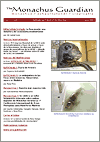Press Watch, Honolulu Advertiser, April 11, 2010
Navy pays for devices that also gauge how sonar affects species
Up to 15 monk seals in Hawai’i will be doing their part over the coming year to help scientists understand them better.
The critically endangered animals will wear small transmitters that reveal their movements, including how deep they dive, when they haul out on land and how far they roam.
Accumulating normal habits of the seals also will be used to gauge the effect Navy training exercises, including use of sonar, may have on the animals.
The Navy is footing the bill for the $4,500-each transmitters, NOAA scientists’ travel and veterinary costs associated with the project. The project is slated to last several years.
Continue reading “High-tech transmitters giving up secret lives of Hawaiian seals”

 Thanks to the support of the Government of the Balearic Islands, Spain, the June 2009 issue of The Monachus Guardian has now been published in Spanish. (Publication of the November 2009 issue will follow shortly.)
Thanks to the support of the Government of the Balearic Islands, Spain, the June 2009 issue of The Monachus Guardian has now been published in Spanish. (Publication of the November 2009 issue will follow shortly.)

